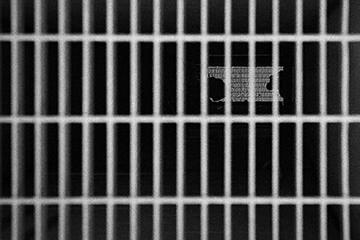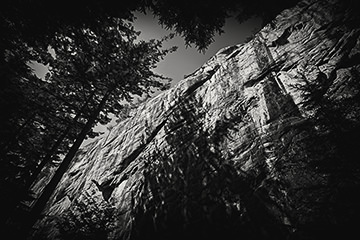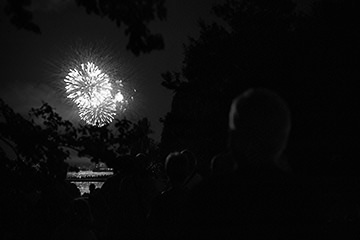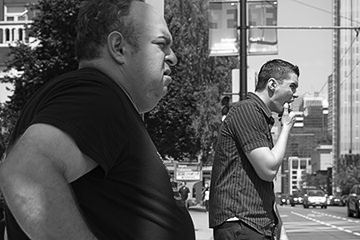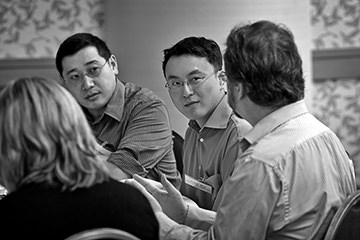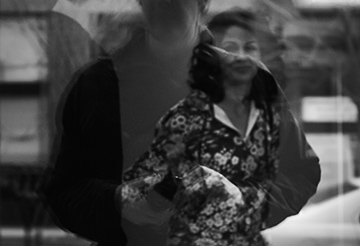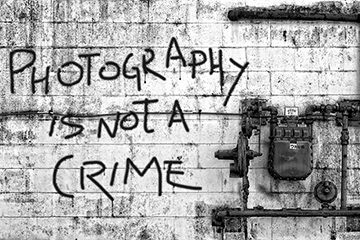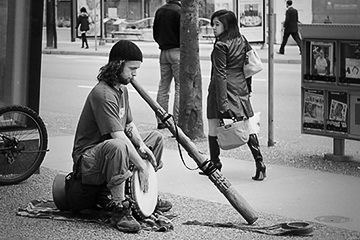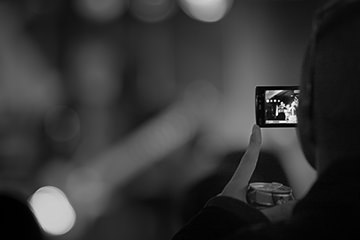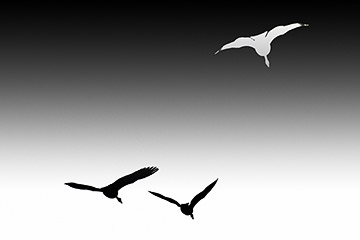The Megapixel Thief (Part 1)
January 2, 2010 CommentsPhoto GearCommon wisdom tells us that "the bigger the sensor, the better the image." Micro Four Thirds (MFT) cameras, though 3 times the price, have a sensor 9 times larger than a point-and-shoot. Great value! The sensor on a full-frame "35 mm" digital camera is 4 times larger than MFT and, coincidentally, costs approximately 4 times as much. Unfortunately, should you wish to shoot digital medium format, you'll run head first into the Law of Diminishing Returns, where a sensor only 1.5 times larger than 35mm currently costs about 7 times as much. Ouch. This article discusses my decision to go "medium format" in a decidedly analog way — by purchasing a 50 year old Yashica-Mat Twin Lens Reflex camera for less than $100. Read along with my tongue-in-cheek logic, and see if you won't end up scouring eBay for your own medium format film camera.
Year One
December 22, 20094 CommentsMusingsThis photo-laden article displays several previously unpublished photos from 2009 and invites the readers to tell me what they do with their own orphaned, unpublished images. It discusses the philosophy behind the ULTRAsomething photography blog, and why I try to achieve a balance between equipment reviews and articles designed to help photographer's develop their own "soul" and style.
The Self Portrait
December 1, 20092 CommentsMusingsMost people would define "self portrait" as a photograph in which the photographer, himself, is the subject. This article discusses how, over the last couple of years, I've come to define "self portraits" in an entirely different way. To me, a "self portrait" is a photograph that reveals something about the photographer's true soul — his proclivities, fantasies, aesthetics, and personality. The photographer, himself, does not need to be the subject. Nor is there any requirement dictating that the photographer need appear anywhere within the photograph at all, Rather, this article asserts that a "self portrait" is a photograph that divulges something of the photographer's inner self.
‘Tween the ‘Weens
November 2, 2009 CommentsMusingsThose of us who photograph the human experience spend 364 days a year trying to be 'the invisible man.' But for one glorious day each calendar year, we street photographers can drop our disguise, emerge from the shadows, and proudly hold our cameras aloft. All Hallows Eve is our night. Halloween is, quite frankly, the easiest pickins a street photographer can get. It's our Labor Day, Christmas, and Thanksgiving all rolled into one.
The ‘Match Technical’ Advantage
October 29, 20093 CommentsPhoto GearLast year, the Leica rangefinder replaced the SLR as my 'go to' camera for reportage, street, documentary, candid, travel, and just plain 'fun' photography. It changed the way I approach these subjects, and made me a better photographer for it. I took to the Leica instantly — coming to grips with its myriad quirks, methodologies, and differences quite easily. Strangely, in spite of the ease with which I was able to mentally grasp the M8, I had no such luck physically. Frankly, the Leica M8 was a hard camera to hold. Gripping it in one hand was a pain — both figuratively and literally. After several months of walking around town squeezing the heck out of the Leica, I finally caved to my internal wimp. I ordered a "Thumbs Up" device from Match Technical. This article discusses my experiences with several Match Technical products — all designed to improve the usability of Leica rangefinders. Included in the review are the "Thumbs Up," the "E-Clypse" eye magnifier, the "Bip" mini soft release, and the "Coder Kit" for coding Leica lenses.
What Color is Happy?
September 29, 2009 CommentsMusingsPhoto Techniques"We humans are quick to embrace new technologies, aesthetics, techniques and trends. We are equally adept at discarding the old ones. And, while few of us would choose to live in the past, its wanton abandonment comes with a heavy price — ignorance." This article discusses why Black & White photography is still relevant.
The Mythical Invisible Shield
September 9, 20091 commentMusingsCameras have an odd psychological effect on me. They have a way of heightening one form of reality, while diminishing others. With my camera in hand, I'm singularly focused on creating the perfect image — one with the potential to entertain, enlighten, inform, or influence those who view it. When I'm on assignment, everything in front of me is filtered through my eyes as if it were already a photograph. Realtime is no longer time at all, but a series of contact sheets from which I'm choosing the images I want to preserve. The result is that non-photographic impulses fail to trigger proper cognition and, subsequently, adequate defenses. This is what I call "the mythical invisible shield." And this article discusses how to use it to your advantage.
Alaskan Cruise Photo Gear Guide
August 18, 20098 CommentsPhoto GearHave you ever hunted through a photography forum for answers to such questions as, "What lens should I take on my Alaskan cruise?" or, "Should I bring a tripod on my Alaskan cruise?" If those forums left you with more questions than answers, I suggest you grab a cup of coffee, click on this link, and get reading. It contains a wealth of statistical information about both lens and camera usage, plenty of analysis comparing different stabilization techniques, and a cornucopia of discussion about all the photographic flotsam and jetsam that you might not even have considered taking aboard. Even if you're not planning an Alaskan cruise, this article might just make you want to take one.
Listen to Your Leica
August 3, 20091 commentMusingsA simple little story about heat stroke, and the way it makes you do crazy things. Like, say, photograph fireworks in black and white on a dark beach in the middle of the night — hand-holding a Leica M8 while using ridiculously long exposures without benefit of a tripod.
Geeking Out with a 50 ‘Cron
July 17, 20092 CommentsPhoto GearThere are geeks and then there are photo geeks. In the old days, geeks worked in carnivals and were oddly entertaining folks who swallowed swords, hammered spikes into their nostrils, and decapitated chickens and snakes without benefit of a cleaver. The photo geek, by contrast, is not nearly so riveting. In fact, photo geeks are downright dull. They photograph things like test charts and brick walls, and talk about spherical aberrations and aperture diffraction rather than composition, light, and shadow. In general, I tend to avoid partaking in the nerdier aspects of photo geekiness. But ever since I began sharing M-mount lenses between the Leica M8 and the Panasonic DMC-G1, I've been consciously aware that they perform quite differently on the two cameras. Because of the way I use these lenses, I'm not actually bothered by this — but readers of this blog feel otherwise, and they asked me to write specifically about the differences between these cameras when using M-mount lenses. This article discusses one such lens — a 1991 Leica v5 50mm f/2 Summicron — and the performance differences one sees when mounting it on a Panasonic DMC-G1 vs. a Leica M8.
Torment of the Innocuous Query
July 8, 20092 CommentsMusings"What do you photograph?" Inevitably, when someone discovers that I'm a photographer, this is their Pavlovian response. It's a question framed in an expression of utmost earnestness — as if they were asking a medical doctor to state his specialty, or an actor to enumerate the roles they had played. It's an Innocuous query, but one I find absolutely impossible to answer... Oh, the torment!
Communicating Discourse
June 22, 2009 CommentsPhoto TechniquesWhat would you do if an event coordinator asked for "action" shots at an event, and that event is about "people sitting around exchanging ideas?" It's just another "Day in the Life" story for the fearless ULTRAsomething photographer.
The M8ing Ritual (Part 3)
June 11, 20095 CommentsPhoto GearIn this third and final entry into my "working" review of the Leica M8, I discuss image fidelity. Specifically, I discuss the obvious visual benefits of shooting a camera without an anti-aliasing filter. I take Leica to task for recording 12-bits of data, but downsampling the RAW files to 8-bit. I conclude with a discussion about rangefinder shooting, and how the Leica M8 and a Micro Four Thirds camera make a potently dynamic duo for reportage.
The M8ing Ritual (Part 2)
June 1, 20091 commentPhoto GearIn Part Two of my report on the Leica M8, I discuss such things as the camera's ergonomics, its shutter noise, and whether or not it succeeds in making me "invisible" on the streets. Granted, they're not the normal topics one discusses when reviewing a camera. But there's nothing "normal" about the unique requirements of a street photographer, either.
The M8ing Ritual (Part 1)
May 25, 2009 CommentsPhoto GearWith my street photography proclivities showing no sign of waning, this article finds me continuing my quest for the "perfect" camera. Earlier this year, I opted for a hybrid approach — mounting rangefinder lenses on a Panasonic DMC-G1 MFT body. The experience was reasonably successful. In fact, it was so much better than my previous attempts to coerce either an SLR or a small "enthusiast" camera into reportage duty, that I soon realized I had to go "all in." And by "all in," I mean "a Leica M8." This article discusses my decision process, and how I came to actually possess an affordable one.
Of Glass Cacophonies
May 1, 2009 CommentsPhoto TechniquesEvery now and then, we all need a little extra inspiration. Many photographers fall into the habit of looking for photos in all the usual places. But by actively looking for photographs in non-standard places, photographers can find photo opportunities that might otherwise bypass them. This article discusses that "art" of looking for interesting reflections in glass surfaces.
The Miscreant Photographer
April 23, 20092 CommentsMusingsOn February 16th, 2009, the UK began to enforce their ambiguously-worded counter-terrorism laws that, essentially, call into question the motives of all photographers and cast doubt upon their actions. Photographing any police officer, military personnel or intelligence official is an 'offense' for which a photographer can now be arrested. The vagueness of the law is nearly as disturbing as the fact it even exists, because it empowers any police officer to detain a photographer and confiscate both equipment and images under the flimsiest veil of legitimacy. As I mourned the vilification of my UK brethren, I took solace in the fact that I lived in Canada — a nation fiercely committed to rights, freedoms, and artistic expression. But is it time for Vancouver photographers to start worrying about the "British" in "British Columbia?"
Shut Up and Shoot
April 7, 2009 CommentsMusingsFor a photography blog, these posts certainly skew toward the wordy. Every now and then I need to exercise a little restraint, and simply let the images do the talking. So, in that spirit, I present a few street shots from the previous couple of weeks — each of which can tell its own story without my usual reams of imposing prose.
The Reel World
April 1, 2009 CommentsMusingsCanada's annual musical celebration, the Juno Awards, descended upon the streets of Vancouver and so, inevitably, did I. It took me only a couple of minutes to grow bored with the musical performances — all of which "borrowed" from classic rock structures of the 1970's, but regurgitated them into soulless clichés. Dismayed by the fact that another generation of musicians was failing to make an imprint on culture, and annoyed that I was neither hearing nor seeing anything new, I lost interest in photographing the bands. Instead, I turned my attention and camera to the audience. And that's when I saw it — the cultural difference between this generation and those that preceded it — the video monitor.
The Positive of Being Negative
March 24, 2009 CommentsPhoto TechniquesLately, I've been thinking about negatives. This might seem curious since I rarely shoot film anymore. So why am I thinking about negatives? Because I'm thinking of them in the stylistic sense, rather than the traditional. Specifically, I've been thinking about creating the opposite of an image — inverting every decision I made in the original capture, and replacing it with its conceptual opposite. Confused? This article explains all.





